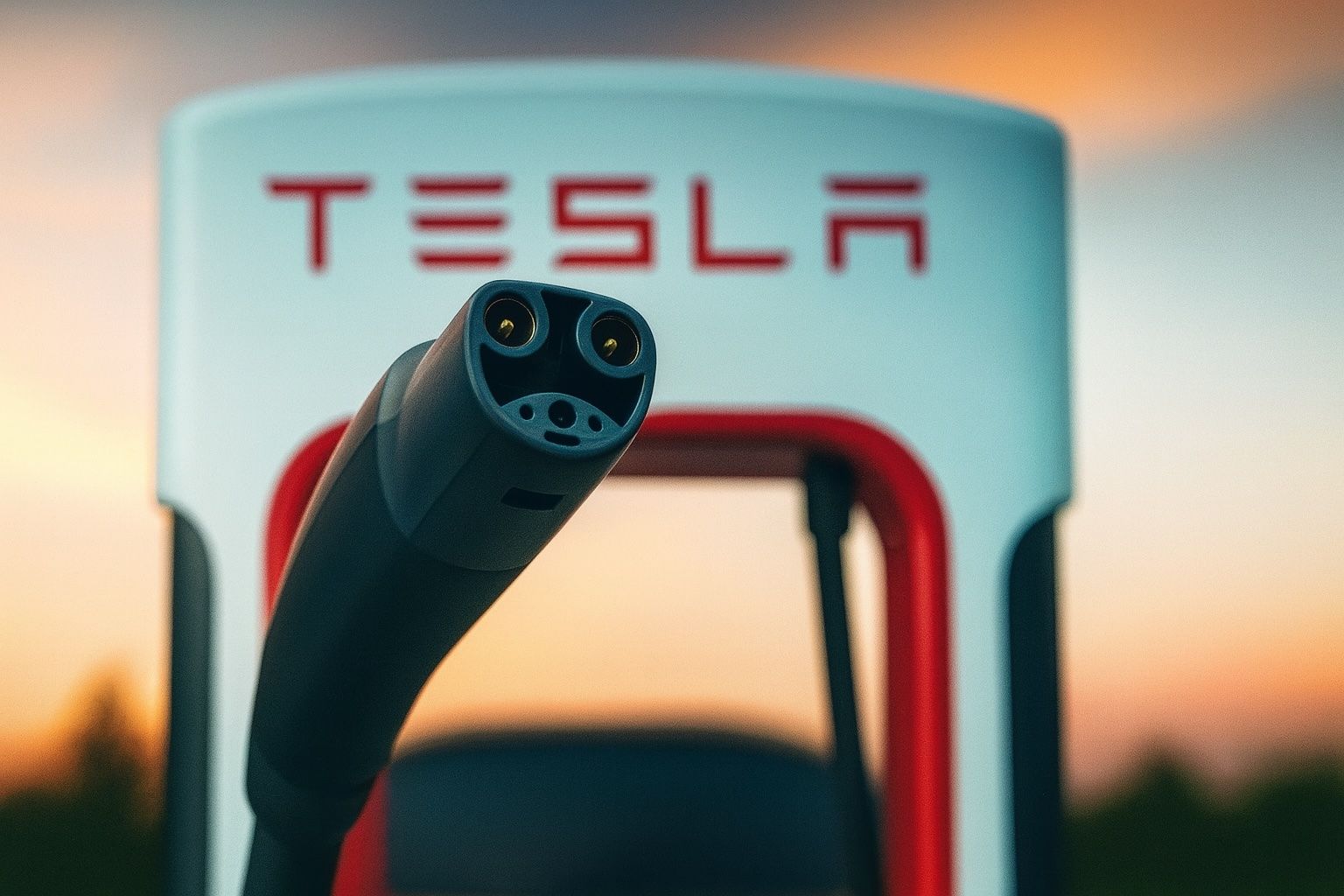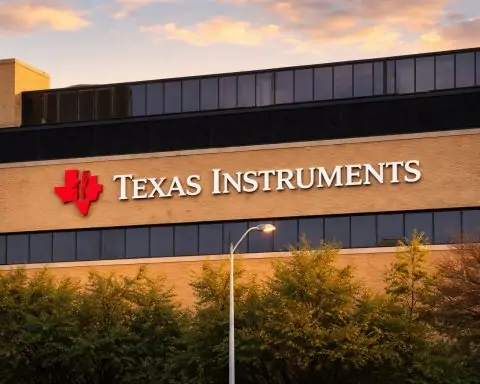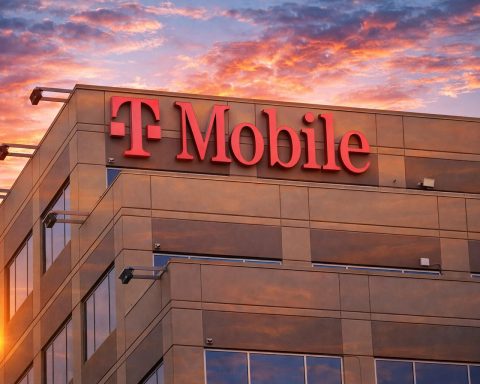- Stock Near Highs: Tesla (TSLA) is trading near its 52-week peak. Shares closed around $439 last week – just shy of the ~$453 high set on Oct. 6 – and are up roughly 80% year-on-year, vastly outperforming the S&P 500’s ~17% gain [1]. As of Monday morning (Oct. 20), TSLA hovered around $445 per share in pre-market trading [2].
- Volatile October: The stock has been on a rollercoaster this month. In one recent week TSLA jumped ~5% in a single day (Oct. 13) only to dip 1.5% the next (Oct. 14) [3]. Earlier in October, shares even spiked to $470 intraday before reversing to close down 5% that same session [4]. Trading volumes have surged during these swings (over 130 million shares on Oct. 2 – more than double typical levels [5]), underscoring the frenzied sentiment around Tesla news.
- Record Sales Boost: Tesla delivered 497,099 vehicles in Q3 2025, an all-time high for a quarter [6] and about 12% above Wall Street’s ~443k forecast [7]. That’s 7.4% higher than a year ago [8]. A late-September rush to beat an expiring $7,500 U.S. EV tax credit fueled the blowout numbers [9] [10], prompting questions about demand going forward.
- “Affordable” Models Debut: On Oct. 7, Tesla rolled out new “Standard Range” versions of its Model Y SUV and Model 3 sedan, priced at about $39,990 and $36,990 respectively [11] [12]. To hit these lower prices, Tesla trimmed features (smaller batteries, no Autopilot Autosteer, etc.), yet both offer over 300 miles of range. CEO Elon Musk touted the move as making Teslas more accessible – but investors were underwhelmed. TSLA stock fell ~4.5% on the announcement [13], as analysts like Wedbush’s Dan Ives said they were “disappointed” the new trims are only ~$5k cheaper than existing models [14] [15].
- Wall Street Divided: Analysts remain split on Tesla’s valuation. Star bulls such as Dan Ives maintain $600 price targets and argue Tesla’s innovations (AI, self-driving, etc.) justify a premium. Morgan Stanley is more cautious around $410 [16]. In fact, the average 12-month analyst target is only ~$364 – below the current price [17]. Roughly half of all analysts rate TSLA a Hold or Sell, often citing its lofty ~$1.4 trillion market cap (around 250× forward earnings) as difficult to justify. Some bears see far more downside – for example, HSBC recently reiterated a rare “Reduce” (Sell) rating with a price target of just $127 [18].
- Earnings on Deck: All eyes are on Tesla’s Q3 2025 earnings report due this Wednesday, Oct. 22 after market close. Consensus estimates predict profit down over 20% year-on-year [19], due to aggressive price cuts and higher costs. However, expectations have been lowered so much that a positive surprise is possible – Wells Fargo analysts, for instance, believe Tesla might beat the Street’s earnings forecasts despite margin pressures [20]. Traders will be scrutinizing whether Tesla’s record deliveries translated into healthy profits or if thinner auto margins undercut the bottom line.
- Musk’s $1 Trillion Pay Plan Under Fire: Tesla’s board has proposed an unprecedented new $1 trillion stock award for Elon Musk, tied to ultra-ambitious goals (e.g. reaching an $8.5 trillion market cap by 2035) [21]. If fully realized, the package could grant Musk about 12% of Tesla’s shares – by far the largest CEO pay deal ever. But the plan is facing pushback: on Friday, influential proxy adviser ISS urged shareholders to vote against the package, calling it “extraordinarily” rich and overly permissive [22]. Tesla investors will vote on the plan at a Nov. 6 meeting, in what’s seen as a referendum on Musk’s leadership and the company’s sky-high future targets.
- Macro & Market Context: Tesla’s stock has benefited from broader tech optimism – hopes that the Federal Reserve might cut interest rates soon have boosted high-growth names like TSLA [23]. Conversely, global risks are a wild card. Any flare-up in U.S.–China trade tensions tends to shake markets (Tesla has major sales and production in China) [24]. Even as U.S. policymakers extend EV incentives for manufacturing, new tariffs (e.g. a 25% duty on imported trucks starting Nov. 1) highlight the unpredictable policy landscape for automakers [25].
- EV Competition Heating Up: Tesla is no longer the only game in town. Global EV sales hit a record 2.1 million units in September (up ~26% YoY), driven largely by China [26]. Tesla has ridden this wave – its Shanghai factory deliveries ticked up in September – but Chinese rival BYD now routinely outsells Tesla and is expanding abroad [27]. In Europe, Tesla’s market share has slipped as legacy automakers and startups roll out dozens of new electric models. Tesla’s sales in Europe (including the UK) fell ~22% in August, shrinking its EV market share there to just 1.5% [28]. Intensifying competition and fading subsidies (for example, Norway phasing out EV tax breaks [29]) mean Tesla must fight harder for each sale.
- Regulatory Scrutiny: Being the EV frontrunner also brings government scrutiny. U.S. auto safety regulators opened a new investigation this month into Tesla’s Full Self-Driving (FSD) software amid reports of cars running red lights and other violations [30]. The probe covers ~2.9 million Teslas – essentially every vehicle with FSD. When news of the investigation broke on Oct. 9, Tesla’s stock slid about 2% intraday [31]. It was a stark reminder that any negative headlines around Autopilot/FSD or recalls can quickly weigh on the stock. As one analysis noted, “Regulatory and legal issues (from Autopilot safety to Musk’s antics) remain wild cards” for Tesla’s outlook [32].
TSLA Stock Soars Amid Volatility
Tesla’s stock has been on a tear in 2025, vastly outperforming the broader market. At around $445 per share today, TSLA sits near its highest levels of the past year [33]. The stock has doubled in value from a year ago (+80% YoY) [34], leaving the S&P 500’s ~17% yearly gain in the dust. Optimism around Tesla’s growth in electric vehicles (EVs), autonomous driving, and clean energy has fueled the rally, propelling the company’s market capitalization to roughly $1.4–$1.5 trillion – one of the world’s largest. By comparison, that valuation eclipses many legacy auto giants combined, and prices Tesla around 250× its forward earnings [35], an exceptionally rich multiple. Bulls argue Tesla deserves it, given rapid sales growth and tech ambitions, while skeptics note that a lot of good news may already be “priced in.”
Recent weeks have showcased Tesla’s signature volatility. The stock has seesawed sharply with each new headline. For example, in early October Tesla shocked the market with record quarterly sales (more on that below), and TSLA briefly spiked to $470 intraday – only to reverse and close down over 5% that same Oct. 2 session as traders “sold the news” [36]. Just days later, sentiment flipped again: on Oct. 13, TSLA surged ~5% amid a broad tech rally, then fell 1–2% the next trading day when macro jitters resurfaced [37]. This rollercoaster pattern – big gains followed by swift pullbacks – has repeated throughout October. Notably, trading volumes have been enormous during these moves. Nearly 89 million shares changed hands last Friday alone, as TSLA jumped 2.5% [38], and earlier in the month single-day volume topped 130 million shares on heavy selling [39]. Such volume indicates active involvement from both institutional investors and day-traders trying to time Tesla’s swings.
What’s driving the turbulence? In part, broader market forces. Tesla, as a high-growth tech-centric stock, often rides the same waves as the NASDAQ. When investors grew hopeful that the Federal Reserve may ease up on interest rates (a positive for growth stocks), TSLA leapt higher alongside other tech names [40]. Conversely, when concerns flared about trade tensions or economic data, Tesla shares have dipped, mirroring those macro jitters [41]. For instance, a brief U.S.–China trade scare in mid-October hit the overall market and contributed to a Tesla pullback [42]. Geopolitics matter for Tesla more directly as well: China is Tesla’s second-largest market and a key production hub, so any worsening in U.S.–China relations or tariffs can spook Tesla investors. (Just last week, Washington announced new 25% tariffs on imported trucks starting Nov. 1 – not directly affecting Tesla’s EVs, but reminding the market that the auto sector is sensitive to trade policy [43].)
At the same time, interest rate trends have been crucial. Tesla’s rich valuation is easier to justify in a low-rate environment, so speculation that rate hikes are ending (or even potential rate cuts by 2024) has provided a tailwind [44]. Lower rates would reduce borrowing costs for car buyers and support higher stock valuations, benefiting Tesla. But if inflation or other factors keep rates high, growth stocks like TSLA could face headwinds. This push-and-pull between macro tailwinds and headwinds has added to Tesla’s recent choppiness.
Finally, it’s worth noting that Tesla’s own news often amplifies these swings. The company is famous for big announcements (and occasional controversies) that send traders rushing in or out. In the span of a few weeks, Tesla has delivered a slew of developments – from blowout sales figures to new product launches and even a controversial pay plan for Musk – each sparking a market reaction. We’ll break those down next. The bottom line for investors is that Tesla’s stock tends to move sharply on any news, good or bad. As a result, TSLA’s short-term trajectory can be unpredictable – a “coiled spring” that can snap in either direction. That reality makes it crucial to stay informed and nimble, especially as the company heads into a pivotal earnings report.
Record Q3 Deliveries Fuel the Rally – But a Hangover Ahead?
One of the biggest catalysts for Tesla’s recent strength was its record-breaking Q3 delivery report. Earlier this month, Tesla announced it had delivered 497,099 vehicles worldwide in the third quarter of 2025 [45]. This is Tesla’s highest quarterly sales ever, handily beating analysts’ consensus of around 441k–444k deliveries [46]. It also marked about a 7.4% increase from Q3 a year ago [47], a notable reacceleration in growth after a more modest first half of 2025.
Investors initially cheered these blowout numbers – proof that demand for Tesla’s EVs remains robust. TSLA stock jumped in early October when the data hit. However, the euphoria was short-lived as the market dug into how Tesla achieved the record and what it means going forward. The company’s own commentary and outside analysts pointed to a major, but temporary, boost: a large number of U.S. buyers rushed to purchase Teslas before a federal tax credit expired on Sept. 30. In Q3, Tesla “went all in” with discounts and deals to drive sales ahead of the expiration of the $7,500 EV credit [48]. This pulled a lot of demand forward into late Q3 – essentially convincing customers who might have bought a Tesla in Q4 (or later) to do so a few months earlier to lock in the savings.
That dynamic has led to questions about a possible Q4 sales hangover. If many buyers simply bought early to snag the tax break, demand in the coming quarter could soften. “I’m skeptical that this will be sustainable and I think we could see a soft couple of quarters,” cautioned Elliot Johnson, CIO at Evolve ETFs (a fund investor in Tesla) [49]. The Q3 surge reflected “pulled-forward demand…rather than growing consumer interest,” he noted, suggesting it wouldn’t be surprising for some investors to “sell the news” and wait to see how Q4 shakes out [50]. In fact, Tesla’s stock did dip over 3% immediately after the record deliveries were released [51], as some traders feared the Q3 “peak” could be followed by a slowdown.
Tesla’s management has likewise been guardedly optimistic. Elon Musk himself hinted back in July that the company might face “a few rough quarters” ahead now that certain subsidies were ending, before growth re-accelerates with new products and technology [52]. Many analysts agree that one strong quarter doesn’t guarantee another. “The challenge now is dealing with the potential slowdown that follows,” observed Matt Britzman, a senior analyst at Hargreaves Lansdown, adding that a truly affordable model will be crucial to keep Tesla’s sales momentum going into next year [53].
On the other hand, Tesla’s Q3 triumph did highlight some positives beyond just car sales. It wasn’t widely reported amid the delivery frenzy, but Tesla’s clean energy division also had a banner quarter – deploying 12.5 GWh of battery storage (like Megapacks for grid use), more than in all of 2024 [54]. This underscores that Tesla’s broader business is expanding; revenue streams such as energy storage and solar installations are growing and can help buffer the company as the auto segment faces pricing headwinds. Moreover, strong demand in markets like China contributed to the Q3 beat. Tesla’s refreshed Model Y and new variants helped lift China sales by ~2.8% in September [55], even as the company navigated a price war in that region. This suggests Tesla can still find pockets of growth and use its global reach to its advantage.
All told, Tesla’s record 497k deliveries in Q3 was a major confidence booster – showing that nearly half a million people bought a Tesla in just three months, a new high-water mark. But the key question now is sustainability. Will Tesla keep up that pace in Q4 and beyond, or was this quarter an outlier thanks to the tax credit? The company’s upcoming earnings and guidance (discussed later) should shed more light. For investors, the scenario is a bit of a double-edged sword: Tesla proved it can drive incredible volume with the right incentives, but it may have effectively borrowed from future sales. As one fund manager put it, “The $7,500 credit definitely…pulled forward demand this quarter” and “could leave a U.S. demand gap in the fourth quarter.” [56] The next few months will reveal whether Tesla’s order books remain strong now that this particular buying rush is over.
New “Affordable” Models Launch – and a Reality Check for Tesla
To keep its sales growing, Tesla is also trying to expand its product lineup downward in price. Earlier this month, the company made waves by introducing new lower-cost “Standard Range” versions of its two most popular cars, the Model Y crossover and Model 3 sedan. These were unveiled on October 7 in the U.S. (with a similar launch in Europe a few days later), and represent Tesla’s latest effort to make its cars attainable to a broader audience.
Tesla’s new Model 3 Standard trim (pictured) offers over 300 miles of range at a starting price around $37k. To achieve a lower price, Tesla removed or downgraded some features – for example, Standard versions have slightly smaller battery packs, lack Autopilot’s Autosteer, and use more basic interiors [57] [58]. The Model Y Standard starts at about $39,990 and the Model 3 Standard at $36,990 in the U.S. [59] [60].
The intent, as Elon Musk often reiterated, is to make Tesla ownership possible for more consumers. He’s long talked about needing a car under $30,000 to reach the masses [61] [62]. While these new Standard Range variants aren’t quite that cheap, they do slide in roughly $4,000–$5,000 below the previous base prices for the Model Y and 3. Crucially, they offer respectable range (about 320 miles on a charge) despite using slightly smaller battery packs – a testament to Tesla’s efficiency improvements.
However, the market’s initial reaction was lukewarm at best. Many analysts and investors were hoping for a more dramatic price drop or an all-new budget model, rather than a feature-trimmed version of existing cars. The starting prices of $39,990 (Model Y) and $36,990 (Model 3) – while lower – struck some observers as still not low enough to unlock a major new wave of demand [63] [64]. After all, with the now-expired U.S. tax credit, those effectively aren’t much cheaper than what buyers were paying a month earlier with incentives. “I just don’t know that this is enough… Tesla needs a sub-$30K EV,” said one investment advisor, expressing doubt that a mid-$30k price point will win over the many price-sensitive consumers still sitting on the sidelines [65] [66].
Wall Street’s verdict was swift: Tesla’s stock fell about 4–5% on Oct. 7–8 once the “affordable” models were announced [67]. Even Dan Ives, a prominent Tesla bull at Wedbush, admitted he was “disappointed” that the new trims are only roughly $5k cheaper than the prior versions [68]. The cuts were seen as too modest to significantly widen Tesla’s addressable market. “The price point is still relatively high…we are relatively disappointed as the price is only $5k lower,” Ives wrote, while maintaining his long-term optimism [69] [70]. Another analyst was blunter, saying “It’s basically a pricing lever and not much of a product catalyst.” In other words, Tesla is tweaking pricing to goose demand, but hasn’t introduced anything fundamentally new to excite consumers [71]. The concern is that these cheaper variants could simply cannibalize sales of the higher trims (people opting for the $37k Model 3 instead of the $42k version) without dramatically growing the total pool of buyers.
From a competitive standpoint, Tesla’s move is arguably defensive. Rival automakers are pushing aggressively into the affordable EV space, and Tesla doesn’t want to be left out. Later in 2024 and 2025, several models priced in the $30k-$40k range are hitting the U.S. and European markets – for example, Chevrolet’s upcoming Equinox EV (around $30k), Hyundai’s Ioniq 5 and Kia’s EV4, not to mention a slew of models from Ford, GM, Volkswagen and others leveraging government incentives. Many of Tesla’s competitors already have EVs under $40,000 (sometimes by offering shorter range or less performance), and new entrants like Chinese automakers are bringing low-cost EVs to Europe. In fact, in Europe, Tesla’s new Standard Model Y and 3 will be up against more than a dozen electric or plug-in hybrid models with price tags below $30k [72]. That includes offerings from brands like Renault, VW’s Skoda, and MG (now owned by China’s SAIC), which are targeting value-conscious buyers.
Tesla’s market share in Europe has been feeling the effects of this competition. In August, for example, Tesla’s European sales dropped about 22.5% compared to the prior year, shrinking its EV market share in Europe to just 1.5% [73]. Some of that decline is due to the overall mix (Tesla had an exceptionally strong August a year ago with Model Y), but it’s also because Volkswagen, BMW, Stellantis (Peugeot, Fiat, etc.) and others are now flooding the zone with new EV models, often at attractive prices or with incentives. And Europe isn’t the only battlefield: in Tesla’s strongest market, the U.S., competitors like Ford (with the Mustang Mach-E and F-150 Lightning) and GM (with electric Cadillacs and Chevys) are vying for customers – as are newcomers like Rivian and Lucid in the higher end.
Perhaps Tesla’s fiercest competitor is emerging in China’s backyard. BYD, the Chinese EV juggernaut, has been outselling Tesla not only in China but globally in total EV units. In Q3, BYD’s sales were slightly down for the first time in years (due to a model transition), yet it still delivered more EVs than Tesla and is expanding to new markets in Asia and Europe [74]. BYD and other Chinese brands offer a range of models across price points, including budget EVs in markets where Tesla doesn’t yet play. This competitive reality is forcing Tesla’s hand – hence the pivot to lower-cost variants now, rather than waiting for a brand-new $25k “Model 2” that is still a couple of years away from production.
Another challenge tied to competition is consumer incentives and regulations. Tesla has benefited greatly from subsidies like the U.S. EV tax credit, but as we saw, those can expire and cause distortions in demand. In Europe, countries that once heavily subsidized EVs (like Norway) are scaling back perks. Norway, for example, is phasing out tax breaks that effectively made Teslas much cheaper; as those vanish over the next two years, Tesla could see sales headwinds in one of its best markets [75]. Meanwhile, competitors sometimes find creative ways to keep prices low – some foreign automakers ship cars with cheaper batteries to qualify for credits, or partner with local firms to get around tariffs. All this means Tesla has to remain nimble on pricing and features to stay competitive on value, not just brand appeal.
The new Standard Range models are one step in that direction – showing Tesla is willing to sacrifice some margin per car to broaden its customer base. They also hint at Tesla’s strategy of incremental change: instead of a dramatically new cheap car, Tesla is leveraging its existing products and simplifying them to cut costs. This has the advantage of speed (these cars went on sale immediately, with deliveries set to begin by December [76]) and lower development risk. But it may not be the game-changer some hoped for. “Longer term, this doesn’t solve the problem posed by lower-cost Chinese competitors…Tesla needs a sub-$30k EV,” warned Shawn Campbell of investment firm Camelthorn [77], reflecting a common view that Tesla will eventually have to do more.
For now, Musk is emphasizing that Tesla is listening to consumers’ pocketbooks. “The desire to buy the car is very high…(it’s) just people don’t have enough money,” Musk said in a recent earnings call, underscoring that affordability is key to Tesla’s mission [78]. The company’s bet is that by lowering prices gradually and improving efficiency, it can stoke enough additional demand to keep growing until truly low-cost models arrive. Investors, however, will be watching closely to see if these Standard Range versions actually boost Tesla’s delivery numbers in upcoming quarters – or if they mostly shuffle existing demand around. Early indications (from the wait times on Tesla’s website) suggest the new trims are generating orders, but it’s too soon to gauge their full impact.
Lastly, no discussion of Tesla’s products and challenges can ignore regulatory oversight, which in October delivered another surprise for the company. On Oct. 9, U.S. regulators at NHTSA opened a formal safety probe into Tesla’s Full Self-Driving (FSD) software amid reports of alarming behavior – namely, cars potentially failing to stop for red lights and even driving into oncoming lanes while using FSD [79] [80]. The investigation covers an estimated 2.88 million Tesla vehicles – basically every car with FSD installed – and was prompted by dozens of incidents, including 14 crashes and 23 injuries, that might be linked to FSD errors [81] [82]. Tesla did push an over-the-air software update addressing some of these issues, but the government’s inquiry is ongoing. The day this news broke, Tesla’s stock fell over 2% as the market digested the implications [83]. It’s a stark reminder that technology risks shadow Tesla’s heroic narrative. Autopilot and FSD are huge parts of Tesla’s future value proposition (and justify, in bulls’ eyes, that high valuation), but they also are under a microscope after several high-profile accidents. Any hint of recalls or stricter regulation could dampen enthusiasm. One market analyst noted that “Regulatory and legal issues (from Autopilot safety to CEO Elon Musk’s antics) remain wild cards” that could inject volatility into Tesla’s story [84]. In short, Tesla must execute nearly flawlessly – not just against competitors, but also in navigating safety standards and public trust – to maintain its edge.
Bulls vs. Bears: Experts Split on Tesla’s Future
Few companies divide Wall Street as sharply as Tesla. The stock’s remarkable rise has minted passionate bulls who see Tesla becoming one of the most valuable and influential tech companies in history. On the other side, skeptics (and outright bears) argue Tesla’s valuation is a bubble resting on unrealistic expectations. As TSLA hovers near all-time highs, that debate is only intensifying.
On the bullish side, the core argument is that Tesla is not just an automaker – it’s a disruptive technology and energy company with multiple avenues for growth. Optimistic analysts point to Tesla’s strides in software (like FSD driving capabilities), its foray into artificial intelligence and robotics, and its expanding energy business as signs that Tesla’s addressable market and profit potential are far larger than a typical car company’s. For example, Wedbush’s Dan Ives has been one of Tesla’s most vocal champions, recently reiterating his $600 price target for the stock (one of the highest on the Street) [85]. Ives believes an “AI-driven valuation” will start to unfold for Tesla, as the company leverages its vast data and neural networks from self-driving, and even ventures into humanoid robots in the coming years [86] [87]. In his bull case, Tesla could reach a $2 trillion market cap by early 2026 and potentially $3 trillion by 2027 [88] – implying the stock price could roughly double or more in about a year. This optimistic scenario hinges on Tesla leading an “Autonomous/AI revolution” in transport and perhaps capturing significant revenue from robotaxis, software subscriptions, and other tech-driven services.
Other bulls highlight Tesla’s strong brand and execution track record. Despite constant skepticism, Tesla has grown its vehicle deliveries more than 10-fold in the last five years, established industry-leading profit margins (until the recent price cuts), and built a charging network and vertical integration that competitors envy. Cathie Wood’s ARK Invest, another notable Tesla bull, has in the past issued very high price targets based on scenarios of Tesla dominating autonomous ride-hailing and other businesses (though ARK’s timelines have been fluid). The essence of the bullish view: Tesla is years ahead of the competition in key areas (battery tech, software, manufacturing scale) and thus can capture an outsize share of the rapidly growing EV market and expand into new profit streams. Bulls often compare Tesla to Apple or Amazon in their early days – expensive by traditional metrics, but ultimately justified by category-defining growth.
On the bearish (or cautious) side, analysts argue that Tesla’s stock price already reflects perfection – and then some. With the company valued at over $1.4 trillion, skeptics note that Tesla is priced as if it will one day be as big as Apple, Google or Amazon in market cap. To warrant that, Tesla would likely need not only to sell millions upon millions of cars, but also dominate in software (self-driving) or other businesses to generate high-margin revenue. Achieving a market cap of, say, $8 trillion (which is actually a target embedded in Musk’s pay plan) would mean Tesla becomes by far the most valuable company on Earth. Many analysts simply don’t see that happening, at least not on the aggressive timeline Tesla fans expect.
In fact, the consensus among Wall Street analysts is notably below Tesla’s current price. The average 12-month price target is around $364 [89] [90] per share – roughly 15–20% lower than where TSLA trades now. And about half of analysts rate Tesla “Hold” or “Sell” rather than a Buy [91]. These more neutral or negative ratings often come from analysts at traditional banks who see Tesla as a car company that, while excellent, is simply overvalued relative to its earnings. They point out that Tesla’s price-to-earnings ratio (P/E) is in the hundreds, whereas other carmakers trade at P/Es in the single digits or teens. Even accounting for growth, Tesla’s valuation implies it will achieve industry dominance akin to a Toyota + Apple + Uber + Energy Utility all rolled into one. That strikes some as far-fetched.
A striking example of the bear case: HSBC recently stuck to its very bearish stance, maintaining a “Reduce” (sell) rating and a price target of just $127 [92]. HSBC’s analysts argue that increasing competition (especially from China’s BYD and others) will erode Tesla’s growth and pricing power, and that Tesla’s forays into things like robotaxis are too uncertain to warrant counting on. They also worry about Tesla’s reliance on Elon Musk – whose attention is split with other ventures (SpaceX, and recently Twitter/X) – and the risk that Musk’s actions or distractions could hurt the company.
Some veteran auto analysts who are bearish also cite fundamental metrics: Tesla’s sales represent only about 20% of what giants like Volkswagen or Toyota sell annually, yet Tesla’s market cap dwarfs those companies’ by multiples. To them, this disconnect suggests Tesla’s stock is riding on narrative and optimism more than on proven financial performance. They point to Tesla’s recent margin decline (auto gross margins fell into the mid-single digits percentage-wise after repeated price cuts [93]) as evidence that Tesla’s growth is coming at the cost of profit – a classic sign of an overheating growth story. If Tesla can’t quickly stabilize or re-expand its margins, the bears argue, its earnings won’t live up to the hype, and the stock could be vulnerable to a big correction.
There are also macro concerns that bears emphasize. High interest rates make car loans more expensive, which could dampen consumer demand for pricey EVs like Teslas. If the economy enters a recession or consumers pull back, Tesla might see demand soften, especially now that it’s not supply-constrained as it once was. Furthermore, Tesla faces potential regulatory hurdles (as discussed, from safety investigations to possible new rules on autonomous tech or emissions) which could add costs or slow its progress. Short-sellers – investors who bet against the stock – have occasionally increased their positions this year, though notably, Tesla has burned many short-sellers in the past as the stock defied gravity.
Interestingly, Tesla’s own actions sometimes flip bulls to bears or vice versa. Morgan Stanley earlier this year made headlines by turning more bullish on Tesla after analyzing the company’s AI supercomputing efforts (its “Dojo” training computer for self-driving). Morgan Stanley’s analyst Adam Jonas raised his target to around $400, citing potential value in Tesla’s network and AI capabilities. Yet Jonas still keeps a more conservative base case (around $250–$300) and acknowledges Tesla’s stock can disconnect from fundamentals. This dual view – recognizing Tesla’s tech prowess but being wary of its valuation – is common among more moderate analysts.
So, who will be right, the bulls or the bears? History has favored the bulls over the past few years, as Tesla continually exceeded many expectations and the stock marched upward. But from here, with Tesla already the world’s most valuable automaker by far, the debate becomes whether Tesla can grow into an almost supernatural valuation. The split in analyst targets – from as low as $120s to as high as $600+ – reflects that uncertainty. It’s possible both sides could be “right” at different times: Tesla’s stock might swing to extremes, soaring on hopeful news and plunging on disappointments. As one analyst put it, until Tesla shows it can translate its booming sales into equally robust profits, “the swings are likely to continue as traders digest every update on EV demand, market strategy, and Musk’s next big ideas.” [94]
For the average investor or interested observer, the Tesla story thus remains a high-stakes drama. It features a visionary CEO with bold bets, disruptive products shaking up a century-old industry, and a share price that is either brilliantly clairvoyant or divorced from reality – depending on whom you ask. In the next section, we look at the near-term events that could tip the scales one way or the other in this ongoing debate.
Looking Ahead: Earnings, Forecasts & Musk’s Mega-Bet
All these discussions come to a head this week as Tesla faces a crucial checkpoint: its third-quarter earnings release. Scheduled for Wednesday, Oct. 22 after the market close [95], the Q3 earnings report and subsequent conference call could be a major inflection point for TSLA stock in the near term. Here’s what to watch:
Wall Street expects a mixed picture. Despite record Q3 deliveries, the consensus is that Tesla’s profits have dipped due to the aggressive price cuts. Analysts forecast that Tesla’s earnings per share will be down over 20% year-on-year [96]. Essentially, Tesla sold a lot more cars but at lower prices and perhaps higher costs, so the net income may be lower than a year ago. Investors will be scouring the results to see how much margin was sacrificed to achieve those big sales numbers. Tesla’s automotive gross margin (ex-credit revenue) was already down to around 17% in Q2, and some predict it could fall closer to low double digits or even single digits in Q3. If so, that might validate the bears’ concern that Tesla is trading profit for volume.
However, expectations have been set so low that Tesla now has a chance to clear a low bar. Many analysts have slashed their earnings estimates over the past quarter, citing the company’s discounts and the fact that new factories (like in Texas and Germany) are still ramping up and not fully efficient. This “lowering of the bar” means that if Tesla even slightly beats the consensus, it could positively surprise the market. For instance, Wells Fargo analysts recently suggested Tesla might outperform the Street’s earnings forecast [97]. They argue that Tesla’s cost efficiencies (in production) and added revenue from things like software (FSD subscriptions) or energy could soften the margin hit. There’s also the possibility Tesla had one-time benefits or accounting items (like recognizing deferred Full Self-Driving revenue if features were delivered) that could boost profit. If Tesla manages to report, say, only a 10% profit drop instead of 20%, or beats the earnings-per-share consensus by a few cents, it might reassure investors that the price cuts were strategic and sustainable rather than destructive to the bottom line.
Beyond the raw numbers, guidance and commentary will be key. Elon Musk and CFO Zachary Kirkhorn (though note: Kirkhorn stepped down in August, and Vaibhav Taneja is the new CFO) will host the earnings call shortly after the results. They will likely discuss: How is demand holding up in Q4 now that the U.S. tax credit boost is gone? Are they seeing any slowdown or need for further price adjustments? What are Tesla’s plans for 2026 targets – can they still aim for ~50% annual growth or is it slowing? Any hints of a new model coming (the long-rumored next-gen platform or compact car)? And how is the Cybertruck launch progressing – Tesla’s first new vehicle in years is supposedly starting deliveries by year-end 2025, so investors will want an update on production ramp and initial demand. Musk’s tone on these issues can significantly sway sentiment. If he’s upbeat and says something like “demand is far exceeding supply” or “we see a path to growing volumes despite economic headwinds,” the market will take note. If he sounds cautious or mentions “uncertainty” and “challenges,” that could stoke worries.
Another big topic is margins and pricing strategy. Will Tesla continue to cut prices to pursue volume, or was Q3 an anomaly? Musk has previously said Tesla will choose higher volume even if it means lower margins in the short term, betting that a larger fleet will yield more future software revenue (robotaxi, etc.). Investors will want to see if that philosophy still holds. It wouldn’t be surprising if on the call Tesla reiterates something like: “Our focus is on making EVs affordable and expanding our customer base, and we believe over time we will achieve industry-leading margins through autonomy and economies of scale.” That said, if cost pressures (like battery materials) are easing, Tesla might hint at margin recovery ahead. Any concrete statements like “we expect our auto gross margin to improve from here” would be very well-received.
Crucially, Tesla might update on its other ventures: Full Self-Driving (FSD) progress, the latest on its Dojo supercomputer, and timelines for things like robotaxis or the Optimus humanoid robot project. Musk is known for making bold predictions (and often pushing out timelines later), but investors will still parse every word for the strategic direction. For example, Musk could announce an expanded FSD beta rollout or improvements (they just released FSD v12 “end-to-end AI” in limited beta). Or he might talk about how Tesla’s AI breakthroughs will open new revenue streams. These forward-looking comments feed the bull narrative and often impact the stock as much as the backward-looking numbers.
Now, aside from earnings, there is a significant corporate event in the offing: the shareholder vote on Musk’s new pay package. As mentioned in Key Facts, Tesla is asking shareholders to approve a $1 trillion performance award for Elon Musk. The vote is set for November 6. We now have more context on that plan: it would grant Musk stock options equal to about 12% of Tesla’s current shares, vesting in tranches only if Tesla hits extremely lofty goals over the next 10 years. Those goals include reaching a market cap of $8.5 trillion (roughly 6× Tesla’s current value) and massive operational targets like producing 20 million cars a year and $400 billion in annual earnings [98]. Hitting all targets would effectively make Tesla by far the largest and most profitable company on the planet. Musk has a track record of setting audacious goals – and sometimes achieving what seems impossible – but even by his standards, this plan is jaw-dropping.
The package has drawn criticism from governance experts and some investors. Just a few days ago, proxy adviser ISS (Institutional Shareholder Services) came out against the plan, urging shareholders to reject it [99]. ISS’s issue is that the award is staggeringly large (they estimate its value at over $100 billion even if only partially achieved) and locks in huge pay opportunities with relatively less flexibility for the board to adjust in future years [100] [101]. They call it excessive and not in shareholders’ best interests. Glass Lewis, another advisory firm, has also recommended voting no, according to reports. Additionally, some state treasurers and pension funds (long-term Tesla investors) have voiced opposition, arguing it’s a distraction and overly enriches Musk, who already owns about 13% of Tesla.
From Tesla’s perspective, the board defends the plan as necessary to keep Musk focused on Tesla. Elon Musk famously draws no traditional salary and only gets compensated via mega-option grants (the last one was in 2018, which ended up paying out as Tesla skyrocketed). The new plan is pitched as aligning Musk’s incentives with shareholders – if he truly delivers unimaginable growth, then he’s handsomely rewarded; if not, the options don’t vest. Some investors actually like this approach, noting that Musk’s vision and leadership are key to Tesla and they want him “all-in” on Tesla’s success (especially since he has other ventures competing for his time). Indeed, when the board first revealed the $1T proposal in September, Tesla’s stock jumped – perhaps because the market assumed Musk would now be extra motivated to drive Tesla’s value up [102].
We can expect this pay plan to be a hot question on the earnings call. Analysts might ask Musk whether he thinks it’s realistic, or how he responds to criticism. Musk has already somewhat addressed it on social media, implying that yes, the targets are “insanely high” but not impossible if Tesla executes perfectly and maybe expands into new industries. For shareholders, the vote will be telling: if it passes, it signals strong confidence in Musk and Tesla’s trajectory (or at least deference to Musk’s leadership). If it gets voted down, that would be a rebuke to the board and Musk – a sign that even some Tesla bulls feel the board needs more oversight on pay and projections. It’s rare for Tesla shareholders to vote against Musk’s wishes, but this could be a close vote given the advisory firms’ stance.
Putting it all together, the next few weeks are pivotal for Tesla. The Q3 earnings will inform us whether Tesla can grow more profitably again or if it’s still in margin-sacrifice mode. The guidance and Musk’s commentary will shape the narrative into 2026: is demand holding up without credits? When will Cybertruck meaningfully contribute? How is Tesla mitigating rising competition in Europe/China? Are there new software or service revenue streams coming (which could boost margins)? On top of that, the outcome of the Musk pay plan vote in early November will add another layer of sentiment – either clearing an uncertainty or raising new questions about Tesla’s governance and Musk’s role.
For now, Tesla enters this week with tremendous momentum but also huge expectations (and some worries) built into its stock price. It’s trading near historic highs on the back of those record sales and bold future visions, yet as we’ve detailed, there are “cracks” that skeptics point out: tighter margins, fierce competition, and an almost heroic growth narrative it needs to live up to. This week’s earnings will be a crucial check-up on Tesla’s financial health and could set the tone for the rest of the year. If Tesla delivers an earnings beat and upbeat outlook, TSLA shares could celebrate and even challenge new highs. If results disappoint or Musk strikes an overly cautious tone, a pullback could be in the cards – especially given the stock’s big run-up.
Either way, one thing is certain: few companies attract as much attention – or react as sharply to news – as Tesla. Investors should brace for more of the trademark volatility. Staying informed is critical, because Tesla’s story can evolve quickly with each development. As one analyst aptly noted, until Tesla’s “booming deliveries have translated into healthy profits,” we can expect the Tesla rollercoaster to keep speeding along [103]. Buckle up, because the next bend in the track is directly ahead.
Sources: This article is based on recent reporting and analysis from TechStock² (ts2.tech), Reuters, and other financial news outlets, providing a comprehensive view of Tesla’s stock performance, business updates, and outlook as of Oct. 20, 2025 [104] [105] [106]. It includes information from Tesla’s official Q3 2025 production release and earnings schedule [107] [108], expert commentary from market analysts [109] [110], and relevant market data on Tesla’s share price and volume [111].
References
1. ts2.tech, 2. www.investing.com, 3. ts2.tech, 4. www.investing.com, 5. www.investing.com, 6. ir.tesla.com, 7. www.reuters.com, 8. www.reuters.com, 9. www.reuters.com, 10. www.reuters.com, 11. www.reuters.com, 12. www.reuters.com, 13. www.reuters.com, 14. www.reuters.com, 15. www.reuters.com, 16. ts2.tech, 17. ts2.tech, 18. ts2.tech, 19. ts2.tech, 20. ts2.tech, 21. www.reuters.com, 22. www.reuters.com, 23. ts2.tech, 24. ts2.tech, 25. ts2.tech, 26. ts2.tech, 27. ts2.tech, 28. www.reuters.com, 29. ts2.tech, 30. www.reuters.com, 31. www.reuters.com, 32. ts2.tech, 33. ts2.tech, 34. ts2.tech, 35. ts2.tech, 36. www.investing.com, 37. ts2.tech, 38. www.investing.com, 39. www.investing.com, 40. ts2.tech, 41. ts2.tech, 42. ts2.tech, 43. ts2.tech, 44. ts2.tech, 45. ir.tesla.com, 46. www.reuters.com, 47. www.reuters.com, 48. www.reuters.com, 49. www.reuters.com, 50. www.reuters.com, 51. www.reuters.com, 52. ts2.tech, 53. www.reuters.com, 54. ts2.tech, 55. ts2.tech, 56. ts2.tech, 57. ts2.tech, 58. www.reuters.com, 59. www.reuters.com, 60. www.reuters.com, 61. www.reuters.com, 62. www.reuters.com, 63. www.reuters.com, 64. www.reuters.com, 65. www.reuters.com, 66. www.reuters.com, 67. www.reuters.com, 68. www.reuters.com, 69. price-target.com, 70. price-target.com, 71. www.reuters.com, 72. www.reuters.com, 73. www.reuters.com, 74. ts2.tech, 75. ts2.tech, 76. www.reuters.com, 77. www.reuters.com, 78. www.reuters.com, 79. www.reuters.com, 80. www.reuters.com, 81. www.reuters.com, 82. www.reuters.com, 83. www.reuters.com, 84. ts2.tech, 85. ts2.tech, 86. price-target.com, 87. price-target.com, 88. price-target.com, 89. ts2.tech, 90. ts2.tech, 91. ts2.tech, 92. ts2.tech, 93. ts2.tech, 94. ts2.tech, 95. ir.tesla.com, 96. ts2.tech, 97. ts2.tech, 98. www.reuters.com, 99. www.reuters.com, 100. www.reuters.com, 101. www.reuters.com, 102. www.reuters.com, 103. ts2.tech, 104. ts2.tech, 105. ts2.tech, 106. www.reuters.com, 107. ir.tesla.com, 108. ir.tesla.com, 109. www.reuters.com, 110. www.reuters.com, 111. www.investing.com







